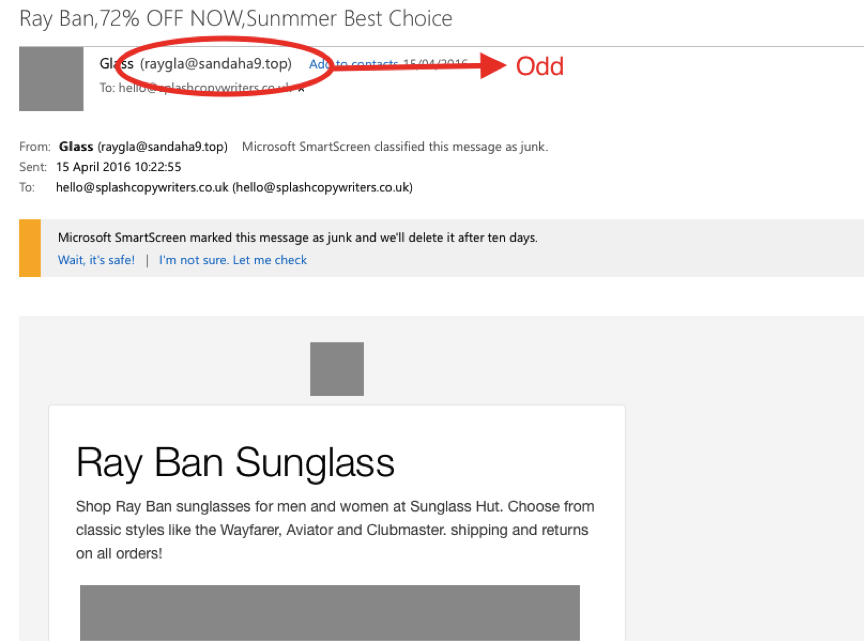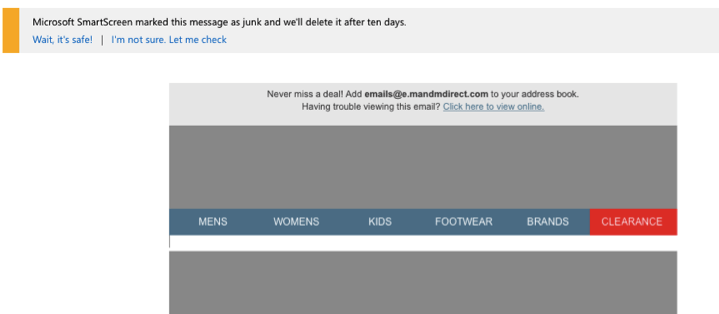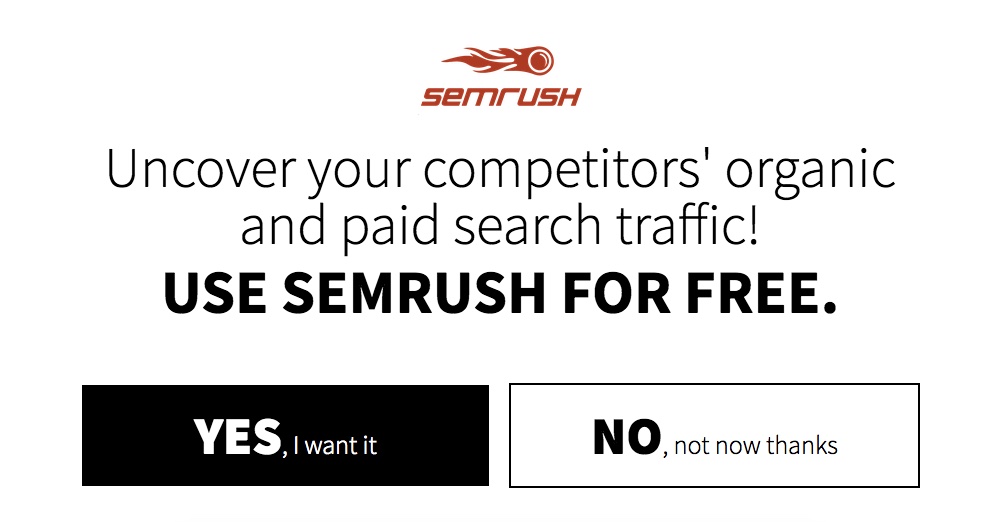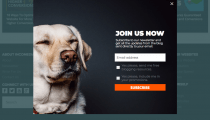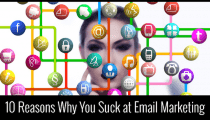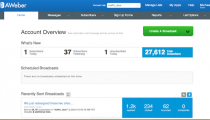Email Deliverability – How to avoid spam filters and land in the inbox
Email Marketing is a subject we have covered here many times before but today we are confronting something that is often neglected and that is email deliverability.
The Junk Folder and how to avoid it!
You see, email marketing can be so unfair at times!
You spend hours, sometimes days, creating and fine-tuning a blog post.
When you’re done, you’re pretty confident that you’ve come up with a killer piece of content.
You hit ‘publish’ and post a link to your article up on social media.
Then, as a serious and savvy blogger, you email your mailing list to promote all your hard work.
But in the next few days, the silence is deafening.
You start to feel underwhelmed and discouraged.
After all, you didn’t sweat blood and tears for a small spike in your website traffic and a few measly retweets, right?
The panic starts setting in. Your email analytics are showing some pretty dismal open rates.
You wonder whether your post was actually that good in the first place.
Or worse still, maybe you start to worry that you’re not cut out to be a blogger after all.
Well, hold on a sec.
The problem might not actually be with your content.
Maybe the issue is with your emails… and how spam filters see them.
Email Deliverability: How to avoid spam filters and land in the inbox
(Updated March 26th, 2021)
(The worrying truth about Email Marketing)
Creating great content is only part of the blogger’s focus.
Just as important is: content promotion.
Email Marketing and Email Deliverability are essential factors to consider in that promotion!
However, when it comes to emailing blog subscribers, we face 2 huge obstacles.
Firstly, having your emails land in a recipient’s junk folder is a really common problem.
Getting junked is arguably the most serious issue you face as a content marketer.
According to ReturnPath, only 81% of commercial emails actually reach an inbox.
When you consider that there are over 100 billion emails are sent and received every day, we’re talking about LOADS of unseen outreach (and untapped value].
The second problem we face is slightly more obvious.
The daily bombardment of emails makes it much harder for the outreach messages that actually do get delivered correctly to get noticed.
However, with both these problems, help is at hand.
The good news is that both issues are related and we can kill two birds with one stone.
With a few small tweaks to your outreach strategy, we can fix this and have you reaping the rewards that your epic efforts deserve.
That sounds more like it, doesn’t it?
The big, unseen barrier to the growth of your blog
You probably know how the whole email thing works.
We all have email, and every email service provider has a built-in spam filter to determine the credibility of each message that we receive.
When an email is sent to us, these email filters analyze a bunch of different factors.
Each factor results in a certain amount of points being scored.
Quite simply, the worse your email measures up against the filter’s criteria, the higher the number of points it scores for each factor.
If the overall points total is too high then forget about it: the email is sent to the junk folder.
Now, it should be said that although email service providers are legally obliged to use spam filters, they’re also there to improve our email experience.
And I guess we should be grateful that spam filters do exist, otherwise we’d be constantly bombarded with daily emails hawking penis enlargement pills, get–rich–quick schemes and singles in your area!
So email filters can wreak havoc with an email marketing campaign, but they’re forcing companies to become more credible.
How to beat the email filters (and boost your blogging ROI)
So the million-dollar question is, what do email filters care about?
Email filters look at a range of technical and content-related things.
You shouldn’t have to worry about the technical stuff, especially if you’re using one of the common email service providers – the likes of MailChimp and AWeber won’t let you down.
Fact is, most emails are labeled as junk because of the content they contain.
Content-related triggers can be obvious or subtle, intentional or unintentional.
11 Email Marketing Tips
Follow this guide to craft the perfect outreach email that will reach your subscriber every time…
1. Take responsibility for your domain.
My first piece of advice is nice and simple: get your domain whitelisted.
You do this by getting a certificate from an authorized source.
Becoming whitelisted is a way of putting your hand up and saying that you’re responsible for your domain.
And email filters trust these certificates implicitly.
It’s a straightforward process; you just need to find a provider and apply. Certificates aren’t free, but they’re pretty cheap.
For a suggested certificate provider, I’d recommend EmailReg.
You just create an account and submit your domain.
They’ll then do some digging.
Assuming you’re legit, they’ll then sort everything out. A certificate with EmailReg costs $20 and lasts a lifetime.
It’s a total no-brainer; we’re talking about a 5-minute job that you’ll never have to do again.
You will find varying opinions about services like EmailReg online — All I can say is it works for me. I guess some people don’t like paying the $20.
We will discuss WhiteListing later in this post but if you suspect you have been Blacklisted – here is a guide on how to get removed from Email Blacklist.
One other thing – when selecting a domain name, always consider if any of the words used in the domain name are considered ‘spammy’ and likely to set off a spam filter (It has been known to happen)
Finally on this subject here is a rather large list of Email SPAM Trigger Words
Of course, issues like this are one of the main reasons Email Marketers end up using Email Services such as Aweber.
Recommended Email Marketing Resource
Want to be a well-paid email copywriter?
Discover how YOU can become a well-paid email copywriter working just 4 hours a day so you have more time, money, energy, and FREEDOM for all the other cool stuff you want to do in life.
Learn how to…
- Use the “rockstar method” to write high-converting emails in 30 minutes or less even if you’ve struggled with writer’s block for years.
- How to generate copywriting clients on-demand at a much HIGHER price point than you currently charge without using outdated and time-consuming strategies like Upwork, blogging, LinkedIn outreach, and working for free.
- AND… how to do ALL of this without being tied to any specific location, so you can work from home, a beach in Thailand, a cabin in the mountains, or wherever YOU most want to live.
2. Avoid using any bizarre email addresses
If there’s one thing that email filters love, it’s an email coming from a source with a clear and consistent brand identity.
Yahoo! mail is particularly well known for paying attention to the ‘from’ field addresses.
When picking your ‘from’ address, stay away from obscure names like ‘werfergere@domain.com’.
Instead, use clear, trustworthy terms like:
contact@
support@
hello@
[your name]@
Also, try not to ever change your address unless you really have to. Consistency is key.
3. Steer clear of any words with a potentially negative context.
Make sure that both the title and the content of your email are written well.
Also, watch out for spelling mistakes:
Remember I mentioned credibility earlier?
Well, one of the biggest culprits for triggering filters is the use of spammy words in your email.
Here is another list of words to avoid in email by Pardot but, in the main, it’s fairly common sense stuff.
For example, avoid phrases like ‘bonus gift’, ‘free prizes’ or ‘don’t delete’.
Got a word you’re not sure about? Then consider how you’d feel if you received an email with it.
Would you think it’s spammy?
Trust your gut. That’ll be the clincher.
A well-respected finance guru here in the UK is Martin Lewis from MoneySavingExpert.com
Mr Lewis is a perfectly credible email source – and at some stage in the past I signed up for his newsletter.
However, that didn’t stop his latest email from ending up in my junk folder.
Here was the title of the email:
It’s trying to say far too much.
Not only that, but it uses abbreviations and appears like a random collection of words.
This is like email junk bingo.
We’ve got ‘urgent’, ‘cheap’ (twice) and ‘£££’.
It would have been better if the title had used a ‘pipe’ symbol (aka vertical bar) as in example below:
4. Take pride in your brand and have a sense of style.
Interestingly, it’s not only the actual words you’ve chosen that set alarm bells ringing for email service providers.
It’s also the style they’re delivered in and how they’re portrayed.
With that in mind, try to avoid:
- Excessive use of capital letters, exclamation points, or other symbols.
- Using too many different font colors, or bold colors like red and green (I personally don’t see the need for anything other than black).
- Doing strange things with a combination of numbers and letters to try and cheat the filters (such as R3ad th1s 3ma1l!).
- Using font sizes larger than 10 or 12pt.
- Stuffing the copy with unnecessary keywords.
- Sending emails with a host of miss-spellings.
- Fancy symbols in subject lines* (see below)
*Opinions on using “fancy symbols” vary – some consider it spammy, but others are Fans, and using Unicode Symbols in subject lines is growing in popularity.
Ultimately, there’s nothing sinister about email filters. We all receive spammy emails and you can tell them a mile off.
Be authentic and original by all means, just have some awareness and use the eyeball test.
5. Double-check your domain name.
Email filters will look at your domain name very closely, more than the actual email address you’re sending from in fact.
Make sure your URL doesn’t contain any potentially offensive words.
This might surprise you, this actually happens a lot by accident.
Take Pen Island Pens, for instance, a business that specializes in selling custom-made pens.
They seem to operate out of Pen Island, one of the remote Canadian arctic islands:
With a URL like that, I’d love to see their open rates.
5. Go easy on the links.
Don’t incorporate too many links within your email, even if they are to your own site.
If you’re linking out to external sites, make sure that they’re reputable domains too.
Limiting links isn’t just something for the benefit of email filters either.
Frankly, it’s annoying to receive an email with a load of links.
Even if a message with too many links did reach the intended recipient, is it actually going to be effective?
It’s asking too much of the reader.
Having multiple links is like trying to open a conversation with someone by offering 10 possible topics to choose from.
It’s weird and it won’t help you reach your goal.
6. For best email deliverability, take care when including images within an email.
Email filters are also known to have a big issue with images:
M&M direct is another bona fide company that should not have a problem sending an email.
But they sent me too many images.
Looking at their email template, there was space allocated for at least 8 pictures, if not more.
I saw none of them.
Exceptionally large images will be a problem, as will having too many images stuffed into a single email in relation to the amount of text.
As an additional piece of housekeeping, ensure that any images you do include within an email are being hosted at a reputable site (something that’s often overlooked).
It’s worth knowing that a lot of email clients automatically block images.
Because of that, the chances are, even if your image-heavy emails do make it to the inbox folder, your recipients won’t see the pictures anyway.
7. Give your recipients a clear ‘unsubscribe’ option.
This is a biggie.
Not having an obvious way of unsubscribing from your newsletter is email suicide.
This might seem obvious, but you’d be surprised at how many people don’t do this (either intentionally or otherwise).
And talking of intentionally trying to beat the system…
8. Never try to pull a fast one and trick an email filter.
Dealing with email filters is a little bit like dealing with Google in SEO.
Make sure that you DON’T:
- Have email subject titles with Re: or Fwd: and make out like there’s been a previous conversation.
- Create words out of symbols, such as F.REE.
- Send any misleading claims.
- Include any images that conceal text.
Here’s an unimaginative email title from a bogus ‘Barclays’ bank:
This is a better attempt, but with an attachment from an unknown source, it’s still going to fail:
9. Show your mailing list some love.
If the money is in the list is the most over-used cliché in marketing, then look after your list has to be the most under-used one.
For a quick win, practice good list management if you want to make sure that your email campaign is successful.
It’s a question of pure logic.
If you’ve sent a number of emails to a prospect and seen no engagement, they should be removed from your mailing lists.
Email filters look at open rates and bounce rates too, so if you don’t stop sending emails to inactive people, the situation is only going to get worse.
The more times you get marked up as spam, the more often it’ll happen.
With me, Groupon is the big losers in this area:
I bought one thing from Groupon about a year ago; now I get daily emails from them.
One probably got sent to my junk folder…
… but now they all do, because Outlook’s email filter is clever enough to recognise that I’ve not dragged anything back to my inbox.
Likewise with Smyth’s toys, the message is loud and clear:
10. Ask your email subscribers to whitelist you.
The elephant in the room.
Yup, one of the best ways to make sure that your mailing list receives your emails is right under your nose.
Just ask them to add you to their contacts!
Even if just a few subscribers do that, it’s a step in the right direction.
This technique is particularly useful at the beginning of your relationship with a new subscriber.
Simply send them a welcome email and ask the question.
Just remember that even if everyone on your email list has agreed to receive mail from you, you should still provide a prominent ‘unsubscribe’ link in your emails.
How to whitelist an email address with Gmail, Outlook.com or Yahoo! Mail
11. Use a tool and become an email Jedi.
There are a number of tools that can help you predict whether how authentic your email might appear.
For instance:
- SenderScore.org can give you an insight into what your customers think of your email campaign, and show you the overall health of your current program.
- Blacklist checks can help you to find out whether your IP has been blacklisted or marked by email providers.
- Tools such as MailingCheck, IsNotSpam, and Experte Spam Checker can evaluate the content of your email for spam.
Below is the result of a test we did using the Experte Spam Checker tool. We used it to check how spammy an email is on five different levels (Spam Assassin score, Google Spam Filter, Gmail Inbox, SPF, and DKIM).
The best part is that unlike some tools which allow you to only test three emails per day, this spam checker can test an unlimited number.
Now you’ve got an action plan.
If your emails aren’t getting seen, then at best, you’re wasting time and effort.
At worst, you’re leaving traffic, revenue, and growth on the table.
Are you happy with that?
Thought not.
Follow those 11 tips and the next time you’re ready to promote one of your babies, you can blast your mailing list without a second thought.
And that way, you’re next job will be a nice one.
You’ll be thinking of your next article rather than stressing over the last one.
You’ll be busy creating another masterpiece, not trying to justify starting this whole painful cycle all over again.
Author Bio: Matt Press is an experienced copywriter who has written words for some of the UK’s biggest brands, such as Sky, Three and Vodafone.
Email Marketing Update
1) GMAIL and Clipping your message
Gmail being the efficient service it is, clips HTML emails that are larger than 102 KB
This means that if your message is greater than 102 KB you will see something like this: [referred to as Message Clipping]
Not exactly what the sender intended!
Not only does the receiver not see your intended message – they will often miss the ‘view entire message’ link.
Worse still, if they cannot see the intended message and an un-subscribe link, there is a real risk of your legitimate email being marked as spam!
A couple of tips:
(a) Stop copy and pasting your email from in particular a WORD DOC (it creates unnecessary HTML that bulks up the message size)
(b) Instead, create your email as a simple text file. A great online service you can use for this is: EditPad
With EditPad it is easy to download and save a clean text file to say your Desktop. Then it is just a case of Copy and Pasting the content of your email into AWEBER, Mailchimp etc.
More information here: Tips To Avoid Message Clipping In Gmail
2) Email marketing is a matter of balance
We had long suspected that using words like Spam or Inbox in an email triggered spam filters. But that did not stop us from using “How to avoid spam filters and land in the inbox” as an alternative subject line in a recent email to our subscribers.
As you can guess, a number of our emails ended up in the Junk Folder.
We learned two things from this…
- A good number of people check their Junk Folder.
- The open rate and clicks % for this subject line was actually higher than an alternative email we sent that did not include those trigger words.
It is a matter of balance – we know our audience wanted to know about Spam Filters – and sometimes if you want to reach people and get the interaction you desire you need to ‘break the rules”. In a busy world with a huge number of emails going into people’s inboxes sometimes you will have to take a risk with subject lines.
#Tip Always use alternative subject lines and measure the response on each. Services like Aweber allow you to email subscribers who did not open an email. When emailing the ‘unopens’ use an alternative subject line. It is not unusual to find that the second email to ‘unopens’ gets a better response.
You should also test sending at different times of day and days of the week.
More Email Marketing Resources
=> 29 Email Marketing Resources To Help You Master Email
=> How To Make Money From Email Marketing and an Autoresponder Series





